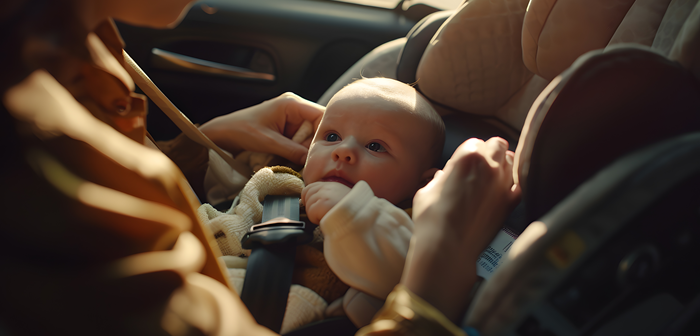In the US, the National Highway Traffic Safety Administration finds that a child is involved in a car accident roughly every 25 seconds. In 2021, these collisions led to 710 fatalities and over 100,000 injuries for children. Among those who lost their lives, 36% were not restrained properly.
“Every US state requires that you use car seats when transporting children in your car,” says Alex Mario, Attorney at Carter Mario Law Firm. “In addition to simply using car seats, these laws also specify that you use the car seat correctly. This means you are responsible for buying the correct car seat, installing it properly, and buckling your child in correctly every time.“
How to know which car seat is best
When parents, guardians, or any adult drives with a child in the vehicle, they are legally responsible for having the correct type of car seat. Child Passenger Safety Laws vary from one state to another, but in all cases, children progress from rear-facing car seats to forward-facing car seats to booster seats.
“Connecticut requires children under two years old or under 30 pounds to be seated in a rear-facing car seat,” notes Mario. “This type of car seat provides the best support for a child’s head, neck, and spine.”
Rear-facing car seats are far and away the most secure way for infants and toddlers to travel. According to the American Academy of Pediatrics, parents should continue to use rear-facing car seats until their children outgrow the maximum weight or height limit set by the seat’s manufacturer.
“Connecticut laws say that children between two and five years old or weighing less than 40 pounds must ride in a child restraint with a five-point harness,” Mario says. “Kids between five and eight, weighing between 40 and 60 pounds, can move to a booster seat that ensures proper fit of the car’s lap and shoulder belts. When children turn eight years old and reach 60 pounds, they can use the car’s regular safety belts.”
How to properly install and use car seats
Purchasing the correct car seat is the first step to ensuring a child’s safety, but parents must go on to ensure that the seat is also correctly installed. Recent research from the National Highway Traffic Safety Administration finds that 46% of parents mistakenly install car seats and booster seats in a way that decreases their effectiveness. “The truth is that nearly half of all parents put their children at risk daily by fastening their car seats incorrectly or buckling them into a car seat that is improperly installed,” remarks Mario.
Some of the most common mistakes include positioning your rear-facing car seat at the wrong angle, securing your car seat or booster seat too loosely, incorrectly positioning your child’s lap belt in a booster seat, incorrectly positioning your child’s chest clip in a car seat, and twisting the harness clips when installing your child’s car seat.
The National Highway Traffic Safety Administration reports that when parents use car seats correctly, they reduce the likelihood of fatalities for infants by 71% and for toddlers by 54%. “To make sure your child’s car seat is installed correctly, start by reading and following the installation instructions from the manufacturer,” Mario suggests. “Next, check your work with an expert. Most local fire and police departments provide regular public safety inspections.”
Correctly using a car seat means consciously checking to ensure children are buckled in properly before every car trip. “Make sure that your child’s harness fits snugly against their body,” Mario says. “Position the chest clip right under your child’s armpits to ensure the car seat’s straps cannot slide off your child’s shoulders. The position of the clips and the straps will change over time, so remember to check and adjust them routinely.”
Does a car seat ever need to be replaced?
Many parents are unaware that they should replace their child’s car seat after a car accident. Even if the car seat appears undamaged, the NHTSA recommends replacing it in the event of a moderate or severe collision.
“The good news is that most insurance companies agree with this recommendation,” says Mario. “If you are not at fault, the other driver’s insurance generally covers the cost of a replacement car seat. In accidents where you are at fault, collision coverage typically covers the replacement. Just remember to specify the exact seat damaged in the accident when you report your claim. That way, you will be sure to receive compensation for a car seat of equal quality and value.”
Every car accident happens in a matter of seconds. In that instant, a parent will never regret the moments they took to purchase the right car seat, install it correctly, and buckle their child securely. Those are the seconds when years of car seat safety make all the difference.





If you’re considering buying a used car in Nevada, checking its background is essential. FaxVin’s https://www.faxvin.com/license-plate-lookup/nevada Nevada license plate lookup is a great tool to get all the details you need. You can find out about previous accidents, ownership history, and any hidden issues. It’s a quick and easy way to ensure you’re making a smart purchase and not getting stuck with a problematic vehicle. Definitely worth using before sealing the deal!
Escape Road‘s easy accessibility—no downloads required—is one of its best qualities. You only need to click once to enter an exciting environment with fluid gameplay and peak performance. The immersive experience draws you further into the chase, regardless of whether you’re playing in full-screen mode or just using your toolbar for a brief session.